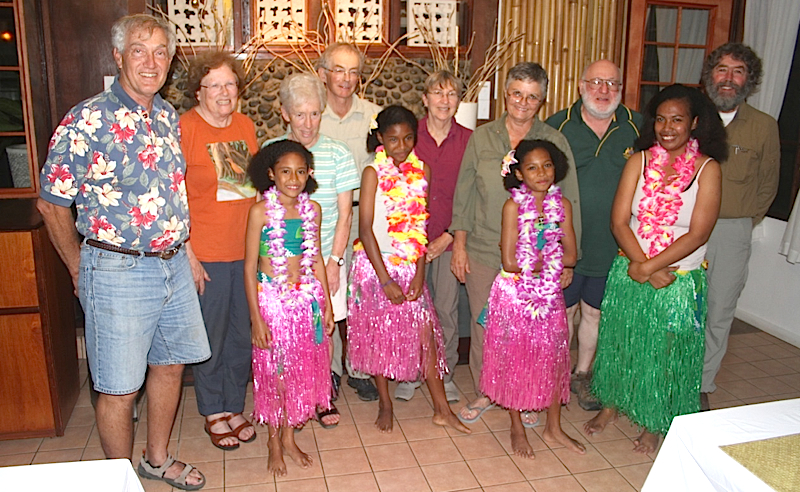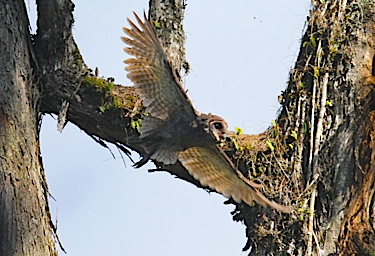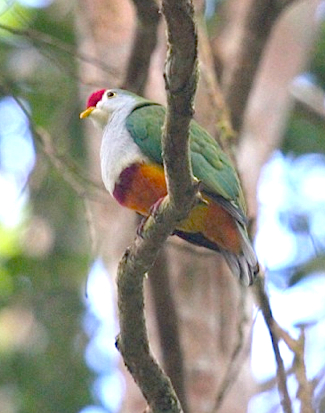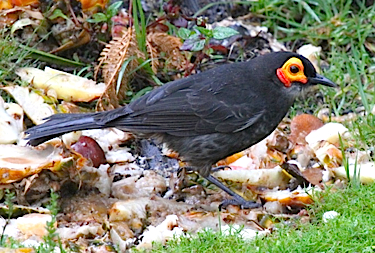For our tour description, itinerary,
past triplists, dates, fees, and more, please VISIT OUR TOUR PAGE.
See this triplist in printable PDF format with media only on
page 1.

A quartet of bright
and beautiful local girls add a splash of color to the group
photo, standing out amidst the muted field dress of the tour
participants. (Photo by guide Phil Gregory)
The small group Field Guides tour of PNG 2012 went there over
the general election, always a more than usually interesting
time, but happily we encountered no problems and even our
flights worked out well, barring a late arrival then a 2-hour
delay on the day we left the country. We had a diverse and
keen group interested in the culture as well as the birds,
which was nice. The staff at our hotel in Port Moresby were
very welcoming, and next day the Raggiana Birds-of-Paradise up
at Varirata gave a nice show, with a supporting cast including
Barred Owlet-Nightjar, Beautiful Fruit-Dove, Brown-headed
Paradise-Kingfisher and White-bellied Whistler, all showing
really well.
Ambua had just had a lot of heavy rain again, but expert
local guide Joseph and the fruiting tree in the lodge grounds
were ready for us, and we swiftly got onto Brown Sicklebill,
Princess Stephanie's Astrapia, Lawes's Parotia, Short-tailed
Paradigalla, Blue BoP, Superb BoP, and a bonus of Loria's
Satinbird (now promoted out of the birds-of-paradise into a
new family). Not bad for the first couple of hours, and the
rain held off!
Next day we went up to below the Tari Gap area, getting above
the fog-shrouded lodge, and had wonderful looks at the bizarre
male King-of-Saxony BoP, some really good Ribbon-tailed
Astrapias, and even a good male Princess Stephanie's Astrapia
despite the roadworks and logging at this site. Wattled
Ploughbill with pink face paddles was another great bird, and
male Regent Whistlers were uncommonly accommodating this trip,
whilst a Lesser Melampitta circumnavigated us and showed quite
well.
Next morning luckily enough the dawn came cold and clear, so
we went for the male Blue Bird-of-Paradise and we quickly got
onto great looks of him at his song post, with Marbled
Honeyeater, Capped White-eye, and Island Leaf-Warbler showing
nicely too. The Sooty Owl also came good, and we enjoyed the
visit there. A Black Sicklebill back at the lodge was a nice
bonus too.
This year we very sensibly flew direct from Ambua to Kiunga,
avoiding the angst of trying to fly into fog-shrouded Tabubil,
but Western Province seems to be regressing rather than
progressing and we had some logistic grievances as well as
quite poor weather. Our guide Samuel is running for local MP
for the quaintly named North Fly Open electorate, so he was
heavily preoccupied, and his senior guide has gone to work for
the gas industry, whilst the bus supplied was like something
out of the Mad Max movies, and the Guest House seemed to have
trouble supplying hot water to some rooms, and doesn't seem to
have spent much money on fittings and decor of late, shall we
say. Still, things in PNG are seldom straightforward and we
made the best of it, and managed some very nice birds.
Boat trip day was distressingly wet; the rain was pretty
unrelenting and much of the morning was really a write-off,
but we did make a comeback with a great male King BoP at his
lek, salvaged a Twelve-wired BoP, had a cooperative Common
Paradise-Kingfisher, saw some wonderful Blyth's Hornbills,
Palm Cockatoo and a flock of the rare Yellow-eyed Starlings.
A male Flame Bowerbird was seen twice, though our guide's
first directions were somewhat problematic, and we managed
displaying Grey-headed Goshawk and Trumpet Manucode here. We
also had a good performance at the Km 17 lek late one
afternoon. Interestingly, what was a hybrid swarm in 2010 has
now been rejuvenated and we had some pretty good-looking male
Greater BoP's moonwalking.
Tabubil was for once dry and we enjoyed good conditions here,
though the Ok Ma Bridge which collapsed when we were here last
trip is still unrepaired. Good birds included 3 Salvadori's
Teal, Doria's Goshawk, the very striking local taxon of Little
Ringed Plover, a late afternoon Pesquet's Parrot, great views
of Yellow-capped Pygmy-Parrot, plus White-eared Bronze-Cuckoo,
Carola's Parotia, Magnificent BoP, Obscure Berrypecker, and
Mountain Peltops.
After a flight across in fine conditions, (the rumored
liquidation of Airlines PNG fortunately being just a rumor),
Kumul Lodge was a second opportunity for some of the high
altitude specials, and the feeders there came good with great
views of Brown Sicklebill and once again the shortest-tailed
adult male Ribbon-tailed Astrapia I've ever seen, plus Brehm's
Tiger-Parrot and very obliging Archbold's Bowerbird and
Mountain Firetail. Other good birds were 3 Crested
Berrypeckers with crests erect, Yellow-breasted Bowerbird, a
bonus Torrent-lark, a big flock of New Guinea White-eyes and
best of all a Feline Owlet-Nightjar after we had been down to
hear a New Guinea (Dusky) Woodcock roding at dusk.
Then it was back (almost on time!) to Port Moresby and a trip
out to the PAU for some nice easy birding--it gives you a
totally false impression of what birding in PNG is like!--and
fine views of a flock iof 47 vagrant Plumed Whistling-Ducks, a
pair of Papuan Frogmouths, Common Kingfisher, and a neat bower
of Fawn-breasted Bowerbird.
The finale was Varirata with Growling (Magnificent) Riflebird
showing all too briefly, a wonderful immature Doria's Goshawk
perched up for scope views, the very distinctive Dwarf
Whistler, Yellow-billed Kingfisher at long last, and a
terrific clown-faced White-faced Robin. The departure day
morning saw us score Silver-eared Honeyeater as a last lifer
before shopping at the amazing PNG Art warehouse.
Thanks to Teresa at FG HQ for good logistics, and to local
guides Leonard, Ben, Joseph, Samuel, Edmund, and Max 1 and Max
2, who all gave a lot to the trip and were ace spotters and
assistants. Thanks also to the group for coming and coping so
well with the various tribulations, to Larry for sharing his
scope and to everyone for an enjoyable and stimulating trip.
Safe travels and hope to meet up again at some point.
--Phil
KEYS FOR THIS LIST
One of the following keys may be shown in brackets for
individual species as appropriate: * = heard only, I =
introduced, E = endemic, N = nesting, a = austral migrant, b =
boreal migrant
Anatidae (Ducks, Geese, and Waterfowl)
PLUMED WHISTLING-DUCK (Dendrocygna eytoni)
WANDERING
WHISTLING-DUCK (Dendrocygna
arcuata)
RADJAH SHELDUCK
(Tadorna radjah)
SALVADORI'S TEAL
(Salvadorina waigiuensis) [E]

The Tari Valley,
highland home of the famous Huli Wigmen, is also home to
this Sooty Owl, which gave us a wonderful showing as it
glided from its day roost in a hollow tree. (Photo by
guide Phil Gregory)
PACIFIC BLACK DUCK (Anas superciliosa)
Megapodiidae (Megapodes)
BLACK-BILLED BRUSH-TURKEY (Talegalla fuscirostris) [E*]
Phasianidae (Pheasants, Grouse, and
Allies)
BROWN QUAIL (Coturnix ypsilophora)
Podicipedidae (Grebes)
AUSTRALASIAN GREBE (Tachybaptus novaehollandiae)
Fregatidae (Frigatebirds)
GREAT FRIGATEBIRD (Fregata minor)
LESSER FRIGATEBIRD
(Fregata ariel)
Phalacrocoracidae (Cormorants and Shags)
LITTLE BLACK CORMORANT (Phalacrocorax sulcirostris)
LITTLE PIED
CORMORANT (Phalacrocorax
melanoleucos)
Anhingidae (Anhingas)
AUSTRALASIAN DARTER (Anhinga novaehollandiae)
Ardeidae (Herons, Egrets, and Bitterns)
GREAT EGRET (AUSTRALASIAN) (Ardea alba modesta)
INTERMEDIATE EGRET
(Mesophoyx intermedia)
LITTLE EGRET
(LITTLE) (Egretta garzetta
nigripes)
PIED HERON
(Egretta picata)
CATTLE EGRET
(ASIAN) (Bubulcus ibis
coromandus)
RUFOUS NIGHT-HERON
(Nycticorax caledonicus)
Threskiornithidae (Ibises and Spoonbills)
AUSTRALIAN IBIS (Threskiornis molucca)
Accipitridae (Hawks, Eagles, and Kites)
PACIFIC BAZA (Aviceda subcristata)
LONG-TAILED
HONEY-BUZZARD (Henicopernis
longicauda) [E]
BLACK KITE (BLACK)
(Milvus migrans affinis)
WHISTLING KITE
(Haliastur sphenurus)
BRAHMINY KITE
(Haliastur indus)
WHITE-BELLIED
SEA-EAGLE (Haliaeetus
leucogaster)
EASTERN
MARSH-HARRIER (PAPUAN) (Circus
spilonotus spilothorax) [E]
VARIABLE GOSHAWK
(Accipiter hiogaster)
BROWN GOSHAWK
(Accipiter fasciatus)
GRAY-HEADED
GOSHAWK (Accipiter
poliocephalus) [E]
DORIA'S GOSHAWK
(Megatriorchis doriae) [E]
Falconidae (Falcons and Caracaras)
AUSTRALIAN KESTREL (Falco cenchroides)
Rallidae (Rails, Gallinules, and Coots)
RED-NECKED CRAKE (Rallina tricolor) [*]
PURPLE SWAMPHEN
(AUSTRALASIAN) (Porphyrio
porphyrio melanopterus)
DUSKY MOORHEN
(Gallinula tenebrosa)
Charadriidae (Plovers and Lapwings)
MASKED LAPWING (Vanellus miles miles)
LITTLE RINGED
PLOVER (SOUTHERN) (Charadrius
dubius dubius)
Jacanidae (Jacanas)
COMB-CRESTED JACANA (Irediparra gallinacea)
Scolopacidae (Sandpipers and Allies)
DUSKY WOODCOCK (NEW GUINEA) (Scolopax saturata rosenbergii) [E*]
Laridae (Gulls, Terns, and Skimmers)
GREAT CRESTED TERN (Thalasseus bergii cristatus)
Columbidae (Pigeons and Doves)
ROCK PIGEON (Columba livia) [I]
SLENDER-BILLED
CUCKOO-DOVE (Macropygia
amboinensis)
BLACK-BILLED
CUCKOO-DOVE (Macropygia
nigrirostris) [E]
GREAT CUCKOO-DOVE
(Reinwardtoena reinwardtii)
[E]
STEPHAN'S DOVE
(Chalcophaps stephani)
PEACEFUL DOVE
(Geopelia placida)
BAR-SHOULDERED
DOVE (Geopelia humeralis)
CINNAMON
GROUND-DOVE (Gallicolumba
rufigula) [*]
THICK-BILLED
GROUND-PIGEON (Trugon
terrestris)
[E*]
WOMPOO FRUIT-DOVE
(Ptilinopus magnificus)
PINK-SPOTTED
FRUIT-DOVE (Ptilinopus
perlatus)
[E]
SUPERB FRUIT-DOVE
(Ptilinopus superbus)
BEAUTIFUL
FRUIT-DOVE (Ptilinopus
pulchellus) [E]
WHITE-BREASTED
FRUIT-DOVE (Ptilinopus rivoli)
[E]
ORANGE-BELLIED
FRUIT-DOVE (Ptilinopus
iozonus) [E]
DWARF FRUIT-DOVE
(Ptilinopus nanus) [E]
PINON
IMPERIAL-PIGEON (Ducula pinon)
[E]
COLLARED
IMPERIAL-PIGEON (Ducula
mullerii) [E]

The name
"Beautiful Fruit-Dove", while appropriate for this bird,
seems to imply that other fruit-doves are not so
attractive, but nothing could be further from the truth.
In fact, this is just one of 6 beautful fruit-doves we saw
on this tour! (Photo by guide Phil Gregory)
ZOE IMPERIAL-PIGEON (Ducula zoeae) [E]
TORRESIAN
IMPERIAL-PIGEON (Ducula
spilorrhoa)
PAPUAN
MOUNTAIN-PIGEON (Gymnophaps
albertisii)
[E]
Cacatuidae (Cockatoos)
PALM COCKATOO (Probosciger aterrimus)
SULPHUR-CRESTED
COCKATOO (Cacatua galerita)
Psittacidae (Parrots)
YELLOW-STREAKED LORY (Chalcopsitta sintillata) [E]
DUSKY LORY
(Pseudeos fuscata) [E]
RAINBOW LORIKEET
(COCONUT) (Trichoglossus
haematodus nigrogularis)
GOLDIE'S LORIKEET
(Psitteuteles goldiei) [E]
BLACK-CAPPED LORY
(Lorius lory) [E]
RED-FLANKED
LORIKEET (Charmosyna
placentis) [E]
PAPUAN LORIKEET
(Charmosyna papou) [E]
YELLOW-BILLED
LORIKEET (Neopsittacus
musschenbroekii) [E]
PESQUET'S PARROT
(Psittrichas fulgidus) [E]
YELLOW-CAPPED
PYGMY-PARROT (Micropsitta
keiensis) [E]
BUFF-FACED
PYGMY-PARROT (Micropsitta
pusio) [E*]
ORANGE-BREASTED
FIG-PARROT (Cyclopsitta
gulielmitertii) [E]
DOUBLE-EYED
FIG-PARROT (Cyclopsitta
diophthalma)
LARGE FIG-PARROT
(Psittaculirostris desmarestii) [E]
BREHM'S
TIGER-PARROT (Psittacella
brehmii) [E]
RED-CHEEKED PARROT
(Geoffroyus geoffroyi)
BLUE-COLLARED
PARROT (Geoffroyus simplex)
[E]
ECLECTUS PARROT
(Eclectus roratus)
PAPUAN KING-PARROT
(Alisterus chloropterus) [E*]
PAPUAN
HANGING-PARROT (Loriculus
aurantiifrons)
[E]
Cuculidae (Cuckoos)
WHITE-CROWNED KOEL (Cacomantis leucolophus) [E]
BRUSH CUCKOO
(Cacomantis variolosus)
CHESTNUT-BREASTED
CUCKOO (Cacomantis
castaneiventris)
FAN-TAILED CUCKOO
(Cacomantis flabelliformis excitus)
RUFOUS-THROATED
BRONZE-CUCKOO (Chrysococcyx
ruficollis) [E*]
WHITE-EARED
BRONZE-CUCKOO (Chrysococcyx
meyeri) [E]
LITTLE
BRONZE-CUCKOO (Chrysococcyx
minutillus) [*]
DWARF KOEL
(Microdynamis parva) [E*]
AUSTRALIAN KOEL
(Eudynamys cyanocephalus)
CHANNEL-BILLED
CUCKOO (Scythrops
novaehollandiae)
GREATER BLACK
COUCAL (Centropus menbeki)
[E*]
PHEASANT COUCAL
(Centropus phasianinus)
LESSER BLACK
COUCAL (Centropus bernsteini)
[E*]
Tytonidae (Barn-Owls)
SOOTY OWL (GREATER) (Tyto tenebricosa arfaki) [E]
Strigidae (Owls)
JUNGLE HAWK-OWL (Ninox theomacha)
[E]
Aegothelidae (Owlet-Nightjars)
FELINE OWLET-NIGHTJAR (Aegotheles insignis) [E]
BARRED
OWLET-NIGHTJAR (Aegotheles
bennettii) [E]
Podargidae (Frogmouths)
PAPUAN FROGMOUTH (Podargus papuensis)
Apodidae (Swifts)
PAPUAN NEEDLETAIL (Mearnsia novaeguineae) [E]
GLOSSY SWIFTLET
(Collocalia esculenta)
MOUNTAIN SWIFTLET
(Aerodramus hirundinaceus)
[E]
UNIFORM SWIFTLET
(Aerodramus vanikorensis)
Hemiprocnidae (Treeswifts)
MOUSTACHED TREESWIFT (Hemiprocne mystacea)
Alcedinidae (Kingfishers)
COMMON KINGFISHER (Alcedo atthis)
AZURE KINGFISHER
(Ceyx azureus) [*]
BLUE-WINGED
KOOKABURRA (Dacelo leachii)
RUFOUS-BELLIED
KOOKABURRA (Dacelo gaudichaud)
[E]
SHOVEL-BILLED
KOOKABURRA (Clytoceyx rex)
[E*]
FOREST KINGFISHER
(Todiramphus macleayii)
SACRED KINGFISHER
(Todiramphus sanctus)
HOOK-BILLED
KINGFISHER (Melidora
macrorrhina) [E*]
YELLOW-BILLED
KINGFISHER (Syma torotoro)
MOUNTAIN
KINGFISHER (Syma megarhyncha)
[E*]
COMMON
PARADISE-KINGFISHER (Tanysiptera
galatea) [E]
BROWN-HEADED
PARADISE-KINGFISHER (Tanysiptera
danae) [E]
BUFF-BREASTED
PARADISE-KINGFISHER (Tanysiptera
sylvia)
Meropidae (Bee-eaters)

Honeyeaters are
an incredibly diverse group in PNG. One of the most
interesting ones is the Smoky Honeyeater, which has the
unique habit of blushing, its yellow facial skin flushing
to a bright red in an instant when the bird is agitated.
This bird seems to be in a state of blush somewhere in
between calm and full agitation. (Photo by guide Phil
Gregory)
RAINBOW BEE-EATER (Merops ornatus)
Coraciidae (Rollers)
DOLLARBIRD (Eurystomus
orientalis)
Bucerotidae (Hornbills)
BLYTH'S HORNBILL (Aceros plicatus)
Pittidae (Pittas)
HOODED PITTA (Pitta sordida) [*]
Ptilonorhynchidae (Bowerbirds)
WHITE-EARED CATBIRD (Ailuroedus buccoides) [E]
SPOTTED CATBIRD
(Ailuroedus melanotis) [*]
ARCHBOLD'S
BOWERBIRD (Archboldia
papuensis) [E]
MACGREGOR'S
BOWERBIRD (Amblyornis
macgregoriae) [E]
FLAME BOWERBIRD
(Sericulus aureus)
[E]
YELLOW-BREASTED
BOWERBIRD (Chlamydera
lauterbachi) [E]
FAWN-BREASTED
BOWERBIRD (Chlamydera
cerviniventris)
Maluridae (Fairywrens)
WHITE-SHOULDERED FAIRYWREN (Malurus alboscapulatus)
[E]
EMPEROR FAIRYWREN
(Malurus cyanocephalus) [E]
Meliphagidae (Honeyeaters)
PLAIN HONEYEATER (Pycnopygius ixoides) [E]
MARBLED HONEYEATER
(Pycnopygius cinereus) [E]
STREAK-HEADED
HONEYEATER (Pycnopygius
stictocephalus) [E]
MOUNTAIN MELIPHAGA
(Meliphaga orientalis) [E]
SCRUB HONEYEATER
(Meliphaga albonotata) [E]
MIMIC HONEYEATER
(Meliphaga analoga) [E]
GRACEFUL
HONEYEATER (ELEGANT) (Meliphaga
gracilis cinereifrons)
[E]
BLACK-THROATED
HONEYEATER (Lichenostomus
subfrenatus)
[E]
OBSCURE HONEYEATER
(Lichenostomus obscurus) [E*]
YELLOW-TINTED
HONEYEATER (Lichenostomus
flavescens)
RUFOUS-BANDED
HONEYEATER (Conopophila
albogularis)
MOUNTAIN MYZOMELA
(Myzomela adolphinae) [E]
RED-COLLARED
MYZOMELA (Myzomela
rosenbergii) [E]
SILVER-EARED
HONEYEATER (Lichmera
alboauricularis) [E]
WHITE-THROATED
HONEYEATER (Melithreptus
albogularis)
MEYER'S FRIARBIRD
(Philemon meyeri) [E*]
HELMETED FRIARBIRD
(NEW GUINEA) (Philemon
buceroides novaeguineae)
TAWNY-BREASTED
HONEYEATER (Xanthotis
flaviventer)
LONG-BILLED
HONEYEATER (Melilestes
megarhynchus) [E*]
SMOKY HONEYEATER
(Melipotes fumigatus) [E]
BELFORD'S
MELIDECTES (Melidectes
belfordi) [E]
YELLOW-BROWED
MELIDECTES (Melidectes
rufocrissalis) [E]
ORNATE MELIDECTES
(Melidectes torquatus) [E]
RUFOUS-BACKED
HONEYEATER (Ptiloprora guisei)
[E]
BLACK-BACKED
HONEYEATER (Ptiloprora
perstriata) [E]
Acanthizidae (Thornbills and Allies)
RUSTY MOUSE-WARBLER (Crateroscelis murina)
[E]
MOUNTAIN
MOUSE-WARBLER (Crateroscelis
robusta) [E]
LARGE SCRUBWREN
(Sericornis nouhuysi) [E]
BUFF-FACED
SCRUBWREN (Sericornis
perspicillatus) [E]
PAPUAN SCRUBWREN
(Sericornis papuensis) [E]
MOUNTAIN GERYGONE
(Gerygone cinerea) [E]
GREEN-BACKED
GERYGONE (Gerygone chloronota)
FAIRY GERYGONE
(Gerygone palpebrosa)

Belford's
Melidectes is among the largest and most garrulous of the
honeyeaters. In highland regions such as at Kumul Lodge,
their loud calls are a regular feature of the soundtrack
of the forest. (Photo by guide Phil Gregory)
YELLOW-BELLIED GERYGONE (Gerygone chrysogaster) [E]
BROWN-BREASTED
GERYGONE (Gerygone ruficollis)
[E]
Pomatostomidae (Pseudo-Babblers)
NEW GUINEA BABBLER (Pomatostomus isidorei) [E]
Cnemophilidae (Satinbirds)
LORIA'S SATINBIRD (Cnemophilus loriae)
[E]
CRESTED SATINBIRD
(Cnemophilus macgregorii) [E]
Melanocharitidae (Berrypeckers and
Longbills)
OBSCURE BERRYPECKER (Melanocharis arfakiana) [E]
BLACK BERRYPECKER
(Melanocharis nigra) [E]
LEMON-BREASTED
BERRYPECKER (Melanocharis
longicauda) [E]
FAN-TAILED
BERRYPECKER (Melanocharis
versteri)
[E]
YELLOW-BELLIED
LONGBILL (Toxorhamphus
novaeguineae) [E]
DWARF HONEYEATER
(Toxorhamphus iliolophus) [E]
PYGMY HONEYEATER
(Toxorhamphus pygmaeum) [E]
Paramythiidae (Tit Berrypecker, Crested
Berrypecker)
TIT BERRYPECKER (Oreocharis arfaki) [E]
CRESTED
BERRYPECKER (Paramythia
montium) [E]
Cinclosomatidae (Quail-thrushes and
Jewel-babblers)
PAINTED QUAIL-THRUSH (Cinclosoma ajax)
[E]
SPOTTED
JEWEL-BABBLER (Ptilorrhoa
leucosticta)
[E*]
BLUE JEWEL-BABBLER
(Ptilorrhoa caerulescens) [E*]
CHESTNUT-BACKED
JEWEL-BABBLER (Ptilorrhoa
castanonota) [E]
Machaerirhynchidae (Boatbills)
BLACK-BREASTED BOATBILL (Machaerirhynchus nigripectus) [E]
YELLOW-BREASTED
BOATBILL (Machaerirhynchus
flaviventer)
Artamidae (Woodswallows)
GREAT WOODSWALLOW (Artamus maximus)
[E]
WHITE-BREASTED
WOODSWALLOW (Artamus
leucorynchus)
Cracticidae (Bellmagpies and Allies)
MOUNTAIN PELTOPS (Peltops montanus) [E]
LOWLAND PELTOPS
(Peltops blainvillii) [E]
BLACK-BACKED
BUTCHERBIRD (Cracticus
mentalis)
HOODED BUTCHERBIRD
(Cracticus cassicus) [E]
BLACK BUTCHERBIRD
(Cracticus quoyi)
Campephagidae (Cuckoo-shrikes)
BLACK-FACED CUCKOO-SHRIKE (Coracina novaehollandiae)
STOUT-BILLED
CUCKOO-SHRIKE (Coracina
caeruleogrisea) [E]
BARRED
CUCKOO-SHRIKE (Coracina
lineata) [*]
BOYER'S
CUCKOO-SHRIKE (Coracina
boyeri)
[E]
WHITE-BELLIED
CUCKOO-SHRIKE (WHITE-BELLIED) (Coracina
papuensis papuensis)
CICADABIRD
(Coracina tenuirostris)
PAPUAN
CUCKOO-SHRIKE (Coracina
incerta) [E]
GRAY-HEADED
CUCKOO-SHRIKE (Coracina
schisticeps)
[E]
NEW GUINEA
CUCKOO-SHRIKE (Coracina melas)
[E]
BLACK-BELLIED
CUCKOO-SHRIKE (Coracina
montana) [E]
GOLDEN
CUCKOO-SHRIKE (Campochaera
sloetii) [E]
VARIED TRILLER
(Lalage leucomela)
Neosittidae (Sittellas)
BLACK SITTELLA (Daphoenositta miranda) [E]
Pachycephalidae (Whistlers and Allies)
MOTTLED WHISTLER (Rhagologus leucostigma) [E]
DWARF WHISTLER
(Pachycare flavogriseum) [E]
RUFOUS-NAPED
WHISTLER (Aleadryas rufinucha)
[E]
BROWN-BACKED
WHISTLER (Pachycephala
modesta) [E]
GRAY-HEADED
WHISTLER (Pachycephala
griseiceps)
SCLATER'S WHISTLER
(Pachycephala soror) [E*]
REGENT WHISTLER
(Pachycephala schlegelii) [E]
BLACK-HEADED
WHISTLER (Pachycephala
monacha)
[E]
WHITE-BELLIED
WHISTLER (Pachycephala
leucogastra) [E]
RUFOUS
SHRIKE-THRUSH (Colluricincla
megarhyncha)
GRAY SHRIKE-THRUSH
(Colluricincla harmonica) [*]
HOODED PITOHUI
(Pitohui dichrous) [E]
RUSTY PITOHUI
(Pitohui ferrugineus) [E*]
VARIABLE PITOHUI
(Pitohui kirhocephalus) [E*]
BLACK PITOHUI
(Pitohui nigrescens)
[E*]
WATTLED PLOUGHBILL
(Eulacestoma nigropectus) [E]
Laniidae (Shrikes)
LONG-TAILED SHRIKE (Lanius schach stresemanni)
Oriolidae (Old World Orioles)
BROWN ORIOLE (Oriolus szalayi) [E]
AUSTRALASIAN
FIGBIRD (Sphecotheres
vieilloti)
Dicruridae (Drongos)
SPANGLED DRONGO (Dicrurus bracteatus carbonarius)
Rhipiduridae (Fantails)
NORTHERN FANTAIL (Rhipidura rufiventris)
WILLIE-WAGTAIL
(Rhipidura leucophrys)
FRIENDLY FANTAIL
(Rhipidura albolimbata) [E]
CHESTNUT-BELLIED
FANTAIL (Rhipidura hyperythra)
[E]
WHITE-BELLIED
THICKET-FANTAIL (Rhipidura
leucothorax leucothorax) [E]
BLACK FANTAIL
(Rhipidura atra) [E*]
DIMORPHIC FANTAIL
(Rhipidura brachyrhyncha) [E]
RUFOUS-BACKED
FANTAIL (Rhipidura rufidorsa)
[E]
Monarchidae (Monarch Flycatchers)
GOLDEN MONARCH (Carterornis chrysomela)
[E]
BLACK-FACED
MONARCH (Monarcha melanopsis)
BLACK MONARCH
(Symposiachrus axillaris) [E*]
SPOT-WINGED
MONARCH (Symposiachrus
guttula) [E]
FRILLED MONARCH
(Arses telescophthalmus) [E]
TORRENT-LARK
(Grallina bruijni) [E]
SHINING FLYCATCHER
(Myiagra alecto)
Corvidae (Crows, Jays, and Magpies)
GRAY CROW (Corvus
tristis) [E]

Of course the
star attractions of PNG are the birds-of-paradise, and
this tour nets a healthy 20+ species of them. They're
generally difficult to photograph, but at least the
aptly-named Brown Sicklebill, like this blue-eyed female,
visits the Kumul Lodge feeders from time to time. (Photo
by guide Phil Gregory)
TORRESIAN CROW (TORRESIAN) (Corvus orru orru)
Paradisaeidae (Birds-of-paradise)
GLOSSY-MANTLED MANUCODE (Manucodia ater) [E]
CRINKLE-COLLARED
MANUCODE (Manucodia
chalybatus) [E]
TRUMPET MANUCODE
(Phonygammus keraudrenii)
SHORT-TAILED
PARADIGALLA (Paradigalla
brevicauda) [E]
RIBBON-TAILED
ASTRAPIA (Astrapia mayeri)
[E]
PRINCESS
STEPHANIE'S ASTRAPIA (Astrapia
stephaniae) [E]
CAROLA'S PAROTIA
(Parotia carolae) [E]
LAWES'S PAROTIA
(Parotia lawesii) [E]
KING-OF-SAXONY
BIRD-OF-PARADISE (Pteridophora
alberti) [E]
MAGNIFICENT
RIFLEBIRD (Ptiloris
magnificus)
MAGNIFICENT
RIFLEBIRD (GROWLING) (Ptiloris
magnificus intercedens) [E]
SUPERB
BIRD-OF-PARADISE (Lophorina
superba) [E]
BLACK SICKLEBILL
(Epimachus fastuosus) [E]
BROWN SICKLEBILL
(Epimachus meyeri) [E]
MAGNIFICENT
BIRD-OF-PARADISE (Cicinnurus
magnificus) [E]
KING
BIRD-OF-PARADISE (Cicinnurus
regius) [E]
TWELVE-WIRED
BIRD-OF-PARADISE (Seleucidis
melanoleucus) [E]
LESSER
BIRD-OF-PARADISE (Paradisaea
minor)
[E]
GREATER
BIRD-OF-PARADISE (Paradisaea
apoda) [E]
RAGGIANA
BIRD-OF-PARADISE (Paradisaea
raggiana) [E]
BLUE
BIRD-OF-PARADISE (Paradisaea
rudolphi) [E]
LESSER MELAMPITTA
(Melampitta lugubris) [E]
GREATER MELAMPITTA
(Melampitta gigantea) [E]
Petroicidae (Australasian Robins)
LESSER GROUND-ROBIN (Amalocichla incerta) [E*]
TORRENT FLYCATCHER
(Monachella muelleriana)
[E]
LEMON-BELLIED
FLYCATCHER (Microeca
flavigaster)
OLIVE FLYROBIN
(Microeca flavovirescens) [E]
CANARY FLYCATCHER
(Microeca papuana) [E]
GARNET ROBIN
(Eugerygone rubra) [E*]
WHITE-FACED ROBIN
(Tregellasia leucops)
BLACK-SIDED ROBIN
(Poecilodryas hypoleuca) [E*]
BLACK-THROATED
ROBIN (Poecilodryas
albonotata) [E]
WHITE-WINGED ROBIN
(Peneothello sigillata)
[E]
WHITE-RUMPED ROBIN
(Peneothello bimaculata) [E*]
BLUE-GRAY ROBIN
(Peneothello cyanus) [E]
ASHY ROBIN
(Heteromyias albispecularis) [E*]
NORTHERN
SCRUB-ROBIN (Drymodes
superciliaris)
Eupetidae (Rail-babbler and Ifrita)
BLUE-CAPPED IFRITA (Ifrita kowaldi) [E]
Hirundinidae (Swallows)
PACIFIC SWALLOW (Hirundo tahitica)
Phylloscopidae (Leaf-Warblers)
ISLAND LEAF-WARBLER (Phylloscopus poliocephalus)
Locustellidae (Grassbirds and Allies)
TAWNY GRASSBIRD (Megalurus timoriensis)
Zosteropidae (Yuhinas, White-eyes, and
Allies)
BLACK-FRONTED WHITE-EYE (Zosterops minor) [E]
CAPPED WHITE-EYE
(Zosterops fuscicapilla) [E]
NEW GUINEA
WHITE-EYE (Zosterops
novaeguineae) [E]
Muscicapidae (Old World Flycatchers)
PIED BUSHCHAT (Saxicola caprata)
Turdidae (Thrushes and Allies)
ISLAND THRUSH (Turdus poliocephalus)
Sturnidae (Starlings)
METALLIC STARLING (Aplonis metallica)
YELLOW-EYED
STARLING (Aplonis mystacea)
[E]
SINGING STARLING
(Aplonis cantoroides)
YELLOW-FACED MYNA
(Mino dumontii) [E]
GOLDEN MYNA
(Mino anais) [E]
Dicaeidae (Flowerpeckers)
RED-CAPPED FLOWERPECKER (Dicaeum geelvinkianum)
Nectariniidae (Sunbirds and Spiderhunters)
BLACK SUNBIRD (Leptocoma sericea)
OLIVE-BACKED
SUNBIRD (Cinnyris jugularis)
Passeridae (Old World Sparrows)
HOUSE SPARROW (Passer domesticus) [I]
EURASIAN TREE
SPARROW (Passer montanus)
[I]
Estrildidae (Waxbills and Allies)
MOUNTAIN FIRETAIL (Oreostruthus fuliginosus) [E]
BLUE-FACED
PARROTFINCH (Erythrura
trichroa)
[*]
HOODED MUNIA
(Lonchura spectabilis)
[E]
GRAY-HEADED MUNIA
(Lonchura caniceps) [E]
SPECKLED DASYURE
(Neophascogale lorentzii) [E]
COMMON NORTHERN
CUSCUS (Phalanger orientalis)
Some nice butterflies were seen on the trip and we should
have a photo archive that can hopefully lead to some
identifications being made. The standard ref. is Parsons, M
(1999) The Butterflies of Papua New Guinea, Academic Press.
This has been remaindered and might be available at something
way below the original very high price.
Species we saw included:
Ulysses Swallowtail
Pearl Owl
Ornithoptera priamus
Trip favorites amongst the birds were hard to pick but the
paradisaeids figured large with the Raggiana and then Greater
Bird-of-Paradise lek displays being huge highlights, along
with the King Bird of Paradise at his display ground, plus the
amazing King-of Saxony and those stunning Brown Sicklebills,
Princess Stephanie's and Ribbon-tailed Astrapias. The Blue BoP
also made a good showing this year and was a trip highlight
for several folks.
Salvadori's Teal was a great sight, as was finally getting a
Feline Owlet-nightjar to show, just sorry not eveyone was
there to enjoy it. Lesser Melampitta was another favorite, as
was Fawn-breasted Bowrbird with its bower, the Yellow-billed
Kingfisher which took so long to come this year, the male
Crested Satinbird and the first time in years we have had a
really good look at Yellow-capped Pygmy-Parrot. Glossy
Swiftlet was also admired, the habit of flying in heavy rain
is truly odd.
Kumul Lodge was enjoyed for its striking architecture,
friendly staff, great bird feeding table and the amazing
orchid Garden developed by Max Mal, whilst the subalpine
grasslands of the Tari Gap are always a terific sight. Our new
hotel in Port Moresby is also a keeper with great staff who
looked after us very well, and even got our footwear cleaned
ready for Oz customs.
Totals for the tour: 302 bird taxa and 2 mammal taxa






